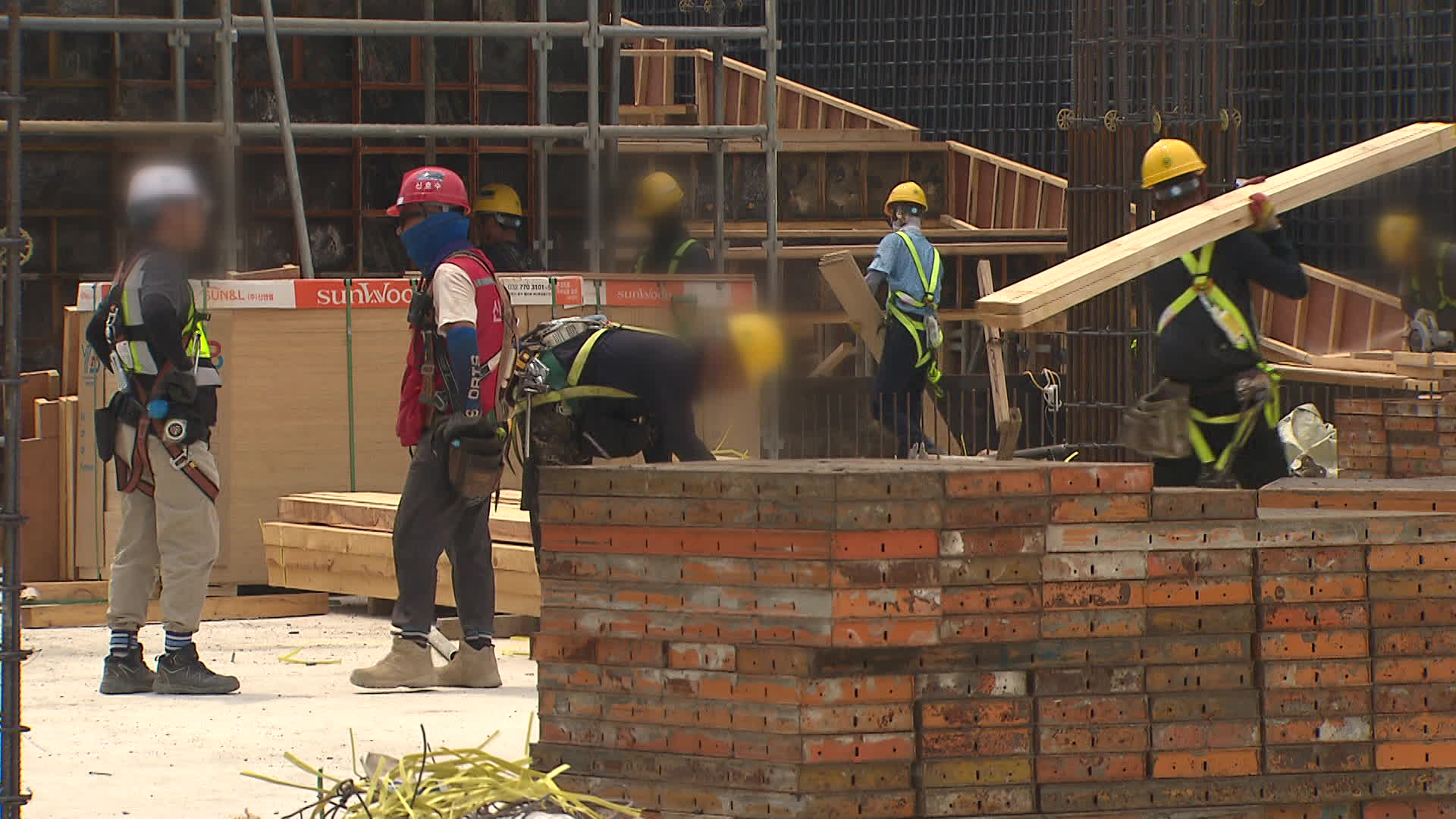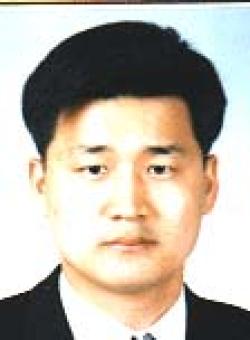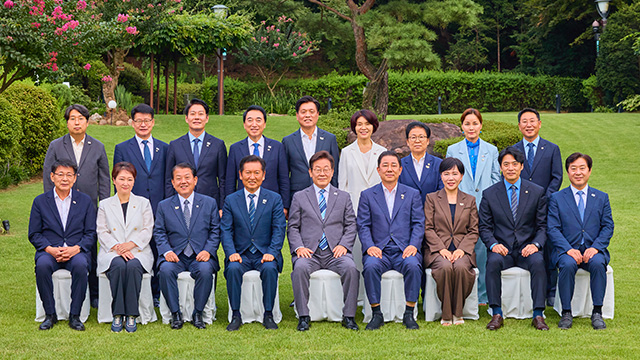[Anchor]
The memory of this summer's sweltering heat is likely to remain as one more intense than in any previous year.
Although it is an unavoidable natural phenomenon, the consequences sometimes develop into social issues.
Among those affected are outdoor workers, who labor to survive in conditions where even breathing is difficult.
Who among us is not struggling with the heat? But who has suffered the most this summer?
We present the numbers.
Yoo Kwang-seok reports.
[Report]
This is a construction site on a day when a heatwave warning was issued.
For workers pouring concrete and carrying heavy materials, the intense labor becomes even more grueling.
[Kim Il-doo/55 years old: "Especially on this cement floor, the heat rises. When I'm already sweating a lot, the hot air makes it hard to breathe sometimes."]
An ambulance rushes a man in his 70s, who collapsed outdoors, to the emergency room.
The patient's body temperature is 39.9 degrees, and he is disoriented and experiencing convulsions.
[Yang Hyuk-jun/Director of the Regional Emergency Medical Center at Gachon University Gil Medical Center: "In cases of heat stroke where the body temperature rises to around 40 degrees and the body cannot regulate temperature, the person is almost unconscious. They may be in a coma, have convulsions, and their pulse quickens as their skin turns red..."]
Last year, over 3,700 heat-related illness patients visited emergency rooms at more than 500 hospitals nationwide, with 2,900 of them being men, which is 3.7 times more than women.
For the past 14 years, the number of male patients has consistently exceeded that of female patients, and the number of heat-related illnesses has increased in years with more heatwave days.
By location, men were most commonly found at outdoor workplaces, rice paddies, and indoor workplaces, in that order, while women were more frequently affected in rice paddies, along roadsides, and at home.
[Ham Seung-heon/Professor of Occupational and Environmental Medicine at Gachon University Gil Medical Center: "For those working outdoors, they are often exposed to direct sunlight, lack shade, and may not have access to water regularly, making them more vulnerable."]
By age group, individuals in their 50s accounted for the highest percentage of heat-related illness cases at 19.3%, followed by those in their 60s at 18.3%.
This trend suggests that people in the retirement or early retirement age group are emerging as a vulnerable population, likely due to economic factors.
The occupation with the highest number of heat-related illnesses is manual laborers, who make up one-quarter of the total.
Among these manual laborers, the most affected age group is those in their 50s at 25.6%, followed by those in their 60s at 18.5%.
[Cho Dong-geun/Emeritus Professor of Economics at Myongji University: "(After retirement) there are no ways to earn income. Public pensions provide only limited support, so people have to earn a living on their own. They may have experienced career interruptions and, in reality, are often limited to simple, repetitive labor."]
Men in their 50s and 60s working in outdoor manual labor jobs.
Tailored measures are needed to protect vulnerable groups affected by heatwaves.
This is KBS News, Yoo Kwang-seok.
The memory of this summer's sweltering heat is likely to remain as one more intense than in any previous year.
Although it is an unavoidable natural phenomenon, the consequences sometimes develop into social issues.
Among those affected are outdoor workers, who labor to survive in conditions where even breathing is difficult.
Who among us is not struggling with the heat? But who has suffered the most this summer?
We present the numbers.
Yoo Kwang-seok reports.
[Report]
This is a construction site on a day when a heatwave warning was issued.
For workers pouring concrete and carrying heavy materials, the intense labor becomes even more grueling.
[Kim Il-doo/55 years old: "Especially on this cement floor, the heat rises. When I'm already sweating a lot, the hot air makes it hard to breathe sometimes."]
An ambulance rushes a man in his 70s, who collapsed outdoors, to the emergency room.
The patient's body temperature is 39.9 degrees, and he is disoriented and experiencing convulsions.
[Yang Hyuk-jun/Director of the Regional Emergency Medical Center at Gachon University Gil Medical Center: "In cases of heat stroke where the body temperature rises to around 40 degrees and the body cannot regulate temperature, the person is almost unconscious. They may be in a coma, have convulsions, and their pulse quickens as their skin turns red..."]
Last year, over 3,700 heat-related illness patients visited emergency rooms at more than 500 hospitals nationwide, with 2,900 of them being men, which is 3.7 times more than women.
For the past 14 years, the number of male patients has consistently exceeded that of female patients, and the number of heat-related illnesses has increased in years with more heatwave days.
By location, men were most commonly found at outdoor workplaces, rice paddies, and indoor workplaces, in that order, while women were more frequently affected in rice paddies, along roadsides, and at home.
[Ham Seung-heon/Professor of Occupational and Environmental Medicine at Gachon University Gil Medical Center: "For those working outdoors, they are often exposed to direct sunlight, lack shade, and may not have access to water regularly, making them more vulnerable."]
By age group, individuals in their 50s accounted for the highest percentage of heat-related illness cases at 19.3%, followed by those in their 60s at 18.3%.
This trend suggests that people in the retirement or early retirement age group are emerging as a vulnerable population, likely due to economic factors.
The occupation with the highest number of heat-related illnesses is manual laborers, who make up one-quarter of the total.
Among these manual laborers, the most affected age group is those in their 50s at 25.6%, followed by those in their 60s at 18.5%.
[Cho Dong-geun/Emeritus Professor of Economics at Myongji University: "(After retirement) there are no ways to earn income. Public pensions provide only limited support, so people have to earn a living on their own. They may have experienced career interruptions and, in reality, are often limited to simple, repetitive labor."]
Men in their 50s and 60s working in outdoor manual labor jobs.
Tailored measures are needed to protect vulnerable groups affected by heatwaves.
This is KBS News, Yoo Kwang-seok.
■ 제보하기
▷ 카카오톡 : 'KBS제보' 검색, 채널 추가
▷ 전화 : 02-781-1234, 4444
▷ 이메일 : kbs1234@kbs.co.kr
▷ 유튜브, 네이버, 카카오에서도 KBS뉴스를 구독해주세요!
- Heat risk for manual laborers
-
- 입력 2025-08-10 01:42:20

[Anchor]
The memory of this summer's sweltering heat is likely to remain as one more intense than in any previous year.
Although it is an unavoidable natural phenomenon, the consequences sometimes develop into social issues.
Among those affected are outdoor workers, who labor to survive in conditions where even breathing is difficult.
Who among us is not struggling with the heat? But who has suffered the most this summer?
We present the numbers.
Yoo Kwang-seok reports.
[Report]
This is a construction site on a day when a heatwave warning was issued.
For workers pouring concrete and carrying heavy materials, the intense labor becomes even more grueling.
[Kim Il-doo/55 years old: "Especially on this cement floor, the heat rises. When I'm already sweating a lot, the hot air makes it hard to breathe sometimes."]
An ambulance rushes a man in his 70s, who collapsed outdoors, to the emergency room.
The patient's body temperature is 39.9 degrees, and he is disoriented and experiencing convulsions.
[Yang Hyuk-jun/Director of the Regional Emergency Medical Center at Gachon University Gil Medical Center: "In cases of heat stroke where the body temperature rises to around 40 degrees and the body cannot regulate temperature, the person is almost unconscious. They may be in a coma, have convulsions, and their pulse quickens as their skin turns red..."]
Last year, over 3,700 heat-related illness patients visited emergency rooms at more than 500 hospitals nationwide, with 2,900 of them being men, which is 3.7 times more than women.
For the past 14 years, the number of male patients has consistently exceeded that of female patients, and the number of heat-related illnesses has increased in years with more heatwave days.
By location, men were most commonly found at outdoor workplaces, rice paddies, and indoor workplaces, in that order, while women were more frequently affected in rice paddies, along roadsides, and at home.
[Ham Seung-heon/Professor of Occupational and Environmental Medicine at Gachon University Gil Medical Center: "For those working outdoors, they are often exposed to direct sunlight, lack shade, and may not have access to water regularly, making them more vulnerable."]
By age group, individuals in their 50s accounted for the highest percentage of heat-related illness cases at 19.3%, followed by those in their 60s at 18.3%.
This trend suggests that people in the retirement or early retirement age group are emerging as a vulnerable population, likely due to economic factors.
The occupation with the highest number of heat-related illnesses is manual laborers, who make up one-quarter of the total.
Among these manual laborers, the most affected age group is those in their 50s at 25.6%, followed by those in their 60s at 18.5%.
[Cho Dong-geun/Emeritus Professor of Economics at Myongji University: "(After retirement) there are no ways to earn income. Public pensions provide only limited support, so people have to earn a living on their own. They may have experienced career interruptions and, in reality, are often limited to simple, repetitive labor."]
Men in their 50s and 60s working in outdoor manual labor jobs.
Tailored measures are needed to protect vulnerable groups affected by heatwaves.
This is KBS News, Yoo Kwang-seok.
The memory of this summer's sweltering heat is likely to remain as one more intense than in any previous year.
Although it is an unavoidable natural phenomenon, the consequences sometimes develop into social issues.
Among those affected are outdoor workers, who labor to survive in conditions where even breathing is difficult.
Who among us is not struggling with the heat? But who has suffered the most this summer?
We present the numbers.
Yoo Kwang-seok reports.
[Report]
This is a construction site on a day when a heatwave warning was issued.
For workers pouring concrete and carrying heavy materials, the intense labor becomes even more grueling.
[Kim Il-doo/55 years old: "Especially on this cement floor, the heat rises. When I'm already sweating a lot, the hot air makes it hard to breathe sometimes."]
An ambulance rushes a man in his 70s, who collapsed outdoors, to the emergency room.
The patient's body temperature is 39.9 degrees, and he is disoriented and experiencing convulsions.
[Yang Hyuk-jun/Director of the Regional Emergency Medical Center at Gachon University Gil Medical Center: "In cases of heat stroke where the body temperature rises to around 40 degrees and the body cannot regulate temperature, the person is almost unconscious. They may be in a coma, have convulsions, and their pulse quickens as their skin turns red..."]
Last year, over 3,700 heat-related illness patients visited emergency rooms at more than 500 hospitals nationwide, with 2,900 of them being men, which is 3.7 times more than women.
For the past 14 years, the number of male patients has consistently exceeded that of female patients, and the number of heat-related illnesses has increased in years with more heatwave days.
By location, men were most commonly found at outdoor workplaces, rice paddies, and indoor workplaces, in that order, while women were more frequently affected in rice paddies, along roadsides, and at home.
[Ham Seung-heon/Professor of Occupational and Environmental Medicine at Gachon University Gil Medical Center: "For those working outdoors, they are often exposed to direct sunlight, lack shade, and may not have access to water regularly, making them more vulnerable."]
By age group, individuals in their 50s accounted for the highest percentage of heat-related illness cases at 19.3%, followed by those in their 60s at 18.3%.
This trend suggests that people in the retirement or early retirement age group are emerging as a vulnerable population, likely due to economic factors.
The occupation with the highest number of heat-related illnesses is manual laborers, who make up one-quarter of the total.
Among these manual laborers, the most affected age group is those in their 50s at 25.6%, followed by those in their 60s at 18.5%.
[Cho Dong-geun/Emeritus Professor of Economics at Myongji University: "(After retirement) there are no ways to earn income. Public pensions provide only limited support, so people have to earn a living on their own. They may have experienced career interruptions and, in reality, are often limited to simple, repetitive labor."]
Men in their 50s and 60s working in outdoor manual labor jobs.
Tailored measures are needed to protect vulnerable groups affected by heatwaves.
This is KBS News, Yoo Kwang-seok.
-
-

유광석 기자 ksyoo@kbs.co.kr
유광석 기자의 기사 모음
-
이 기사가 좋으셨다면
-
좋아요
0
-
응원해요
0
-
후속 원해요
0











![[단독] ‘5천만 원짜리 시계, 모른다’던 김건희…‘고가 가방 영상’ 속 손목 보니](/data/news/title_image/newsmp4/news9/2025/08/20/20_8335377.png)

![[단독] 사고 4달 전 ‘낙하물방지물’ 지적…추락 위험 경고만 수차례](/data/layer/904/2025/08/20250820_fFqQYJ.png)

이 기사에 대한 의견을 남겨주세요.